
Stuttgart is the capital and largest city of the German state of Baden-Württemberg. It is located on the Neckar river in a fertile valley known as the Stuttgarter Kessel and lies an hour from the Swabian Jura and the Black Forest. Stuttgart has a population of 632,865 as of 2022, making it the sixth largest city in Germany, while over 2.8 million people live in the city's administrative region and nearly 5.5 million people in its metropolitan area, making it the fourth largest metropolitan area in Germany. The city and metropolitan area are consistently ranked among the top 4 European metropolitan areas by GDP; Mercer listed Stuttgart as 21st on its 2015 list of cities by quality of living; innovation agency 2thinknow ranked the city 24th globally out of 442 cities in its Innovation Cities Index; and the Globalization and World Cities Research Network ranked the city as a Beta-status global city in their 2020 survey. Stuttgart was one of the host cities for the official tournaments of the 1974 and 2006 FIFA World Cups.
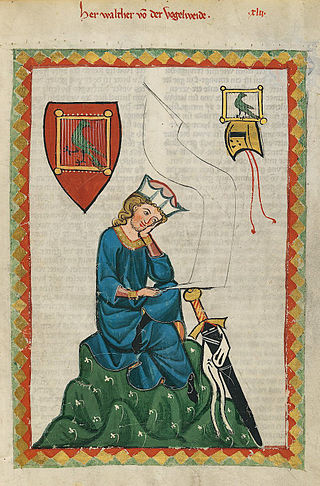
Walther von der Vogelweide was a Minnesänger who composed and performed love-songs and political songs (Sprüche) in Middle High German. Walther has been described as the greatest German lyrical poet before Goethe; his hundred or so love-songs are widely regarded as the pinnacle of Minnesang, the medieval German love lyric, and his innovations breathed new life into the tradition of courtly love. He was also the first political poet to write in German, with a considerable body of encomium, satire, invective, and moralising.
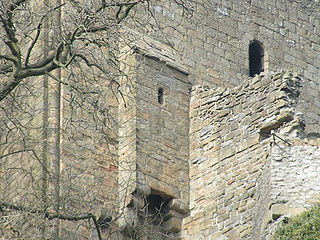
Garderobe is a historic term for a room in a medieval castle. The Oxford English Dictionary gives as its first meaning a store-room for valuables, but also acknowledges "by extension, a private room, a bed-chamber; also a privy".

Ortnit is the eponymous protagonist of the Middle High German heroic epic Ortnit. First written down in strophic form in around 1230 by an anonymous author, it circulated in a number of distinct versions.
From the 12th century in central Europe, a Burgmann was a knight ministeriales or member of the nobility who was obliged to guard and defend castles. The role is roughly equivalent to the English castellan and the name derives from the German word for castle, Burg.

The inner bailey or inner ward of a castle is the strongly fortified enclosure at the heart of a medieval castle. It is protected by the outer ward and, sometimes also a Zwinger, moats, a curtain wall and other outworks. Depending on topography it may also be called an upper bailey or upper ward.

Ordensburg Vogelsang is a former Nazi complex located within the former military training area of Vogelsang in the Eifel National Park in North Rhine-Westphalia.

Altdahn Castle is a castle ruin in the Palatinate Forest, the German part of the Wasgau region. It is located near the town of Dahn in Rhineland-Palatinate, Germany. It stands 337 metres (1,106 ft) above sea level (NN).
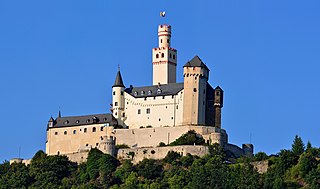
A hill castle or mountain castle is a castle built on a natural feature that stands above the surrounding terrain. It is a term derived from the German Höhenburg used in categorising castle sites by their topographical location. Hill castles are thus distinguished from lowland castles (Niederungsburgen).

The term lowland castle or plains castle describes a type of castle that is situated on a lowland, plain or valley floor, as opposed to one built on higher ground such as a hill spur. The classification is extensively used in Germany where about 34 percent of all castles are of the lowland type.

A hillside castle is a castle built on the side of a hill above much of the surrounding terrain but below the summit itself. It is thus a type of hill castle and emerged in Europe in the second half of the 11th century. As a result of the particular danger to the site from attacks on the castle from the rising ground above it, this weak point is usually strongly protected by a shield wall or a Bergfried. Often a combination of these two passive defensive works were used.
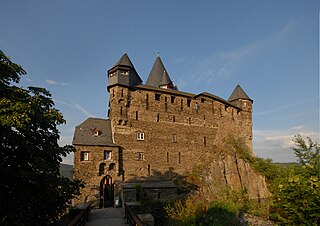
A shield wall, also shield-wall or Schildmauer, refers to the highest and strongest curtain wall, or tower of a castle that defends the only practicable line of approach to a castle built on a mountain, hill or headland. German sources may refer to a shield wall that protects two or more sides as a Hoher Mantel or Mantelmauer, which is variously translated as "mantle-wall", "mantle wall" or "high screen-wall". There is often no clear, definitive distinction between a shield wall and a mantle wall.
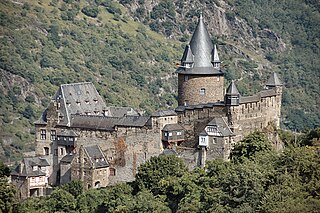
A toll castle is a castle that, in the Middle Ages and the Early Modern Era, guarded a customs post and was intended to control it. They were typically found in the Holy Roman Empire. Toll castles always stood in the vicinity of an important long-distance trade route over, for example, the Alpine passes or the Middle Rhine. Such castles were usually placed at strategic locations, such as border crossings, river crossings or mountain passes, and were manned by armed guards. The actual toll-collecting point lay below at the road or river and was often linked by walls to the castle itself.
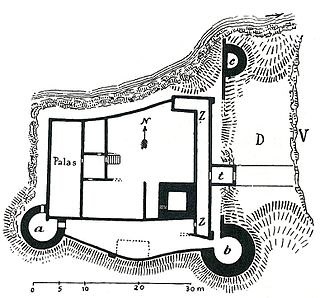
A neck ditch, sometimes called a throat ditch, is a dry moat that does not fully surround a castle, but only bars the side that is not protected by natural obstacles. It is often an important element in the defensive system of hill castles, especially in Germany and other parts of Central Europe.
A Ganerbenburg is a castle occupied and managed by several families or family lines at the same time. These families shared common areas of the castle including the courtyard, well, and chapel, whilst maintaining their own private living quarters. They occurred primarily in medieval Germany.

An outer bailey or outer ward is the defended outer enclosure of a castle. It protects the inner bailey and usually contains those ancillary buildings used for the management of the castle or the supply of its occupants. These domestic buildings could include workshops, livestock stalls and stables; storage facilities such as barns, sheds and granaries, as well as quarters for servants such as maids, farm workers, and even the castle governors or castellans. In many cases there was also a brewery, a bakehouse and a kitchen, if the latter was not located in the hall or palas. An outer bailey was often called a base court in England. Depending on topography it could also be referred to as a lower bailey or lower ward, the keep being in the upper bailey or ward. Chepstow Castle has lower, middle and upper baileys.

A Zwinger is an open kill zone area between two defensive walls that is used for defensive purposes. Zwingers were built in the medieval and early modern periods to improve the defence of castles and town walls. The term is usually left untranslated, but is sometimes rendered as "outer courtyard", presumably referring to the subsequent role of a Zwinger as a castle's defences became redundant and it was converted into a palace or schloss; however, this belies its original purpose as a form of killing ground for the defence. The word is linked with zwingen, "to force", perhaps because the Zwinger forced an enemy to negotiate it before assaulting the main defensive line. Essenwein states that the "main purpose of this feature was so that the besieging force could not reach the actual castle wall very easily with battering rams or belfries, but had to stop at the lower, outer wall; also that two ranks of archers, behind and above one another, could fire upon the approaching enemy".
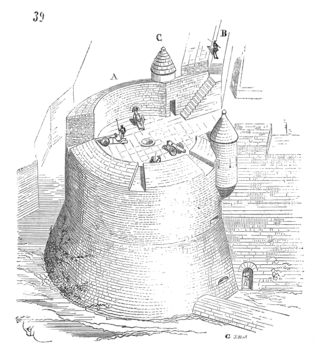
The roundel is an artillery fortification with a rounded or circular plan of a similar height to the adjacent defensive walls. If the fortification is clearly higher than the walls it is called a battery tower.

A tower castle is a small castle that mainly consists of a fortified tower or a tower-like structure that is built on natural ground. It is thus different from the motte-and-bailey castle, which it may resemble, but whose main defensive structure is built on a motte or artificial hill. The tower castle is occasionally also described as a tower house castle or a tower house.

A butter-churn tower is a two-part defensive tower in which the upper section has a smaller width than the lower section.



















